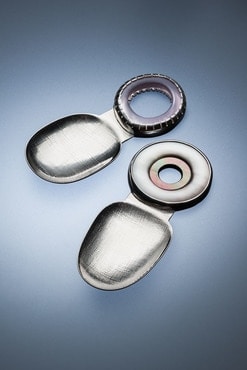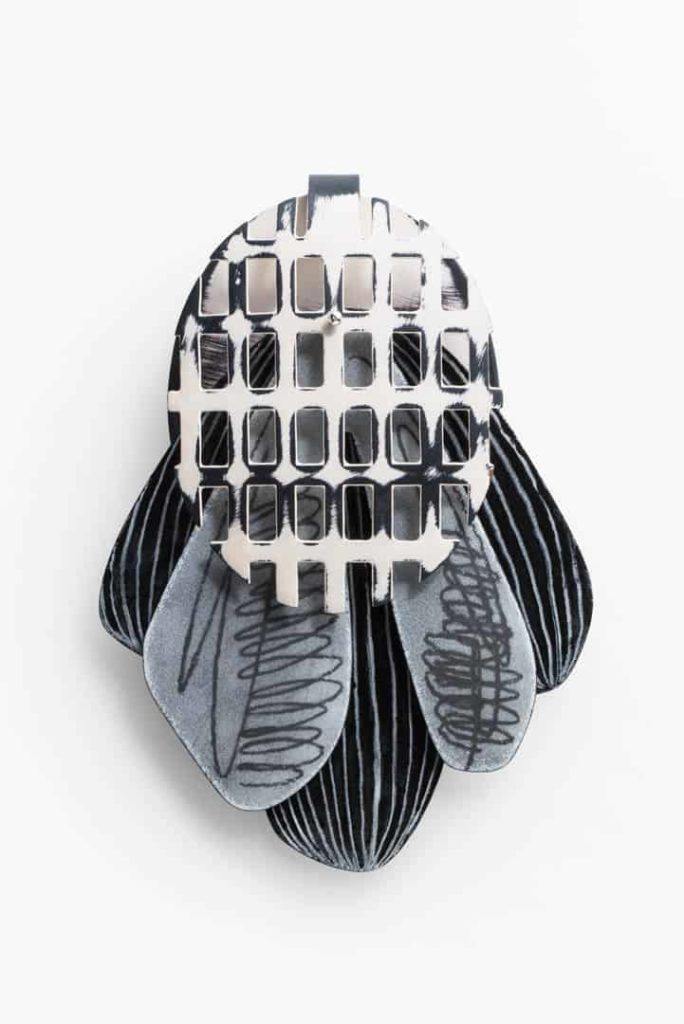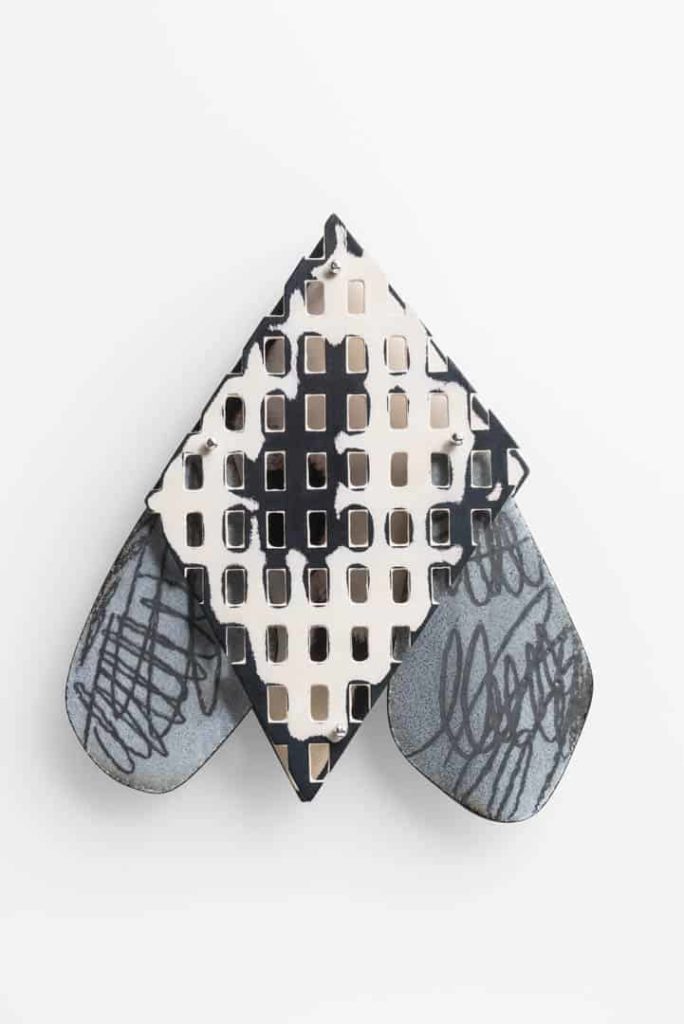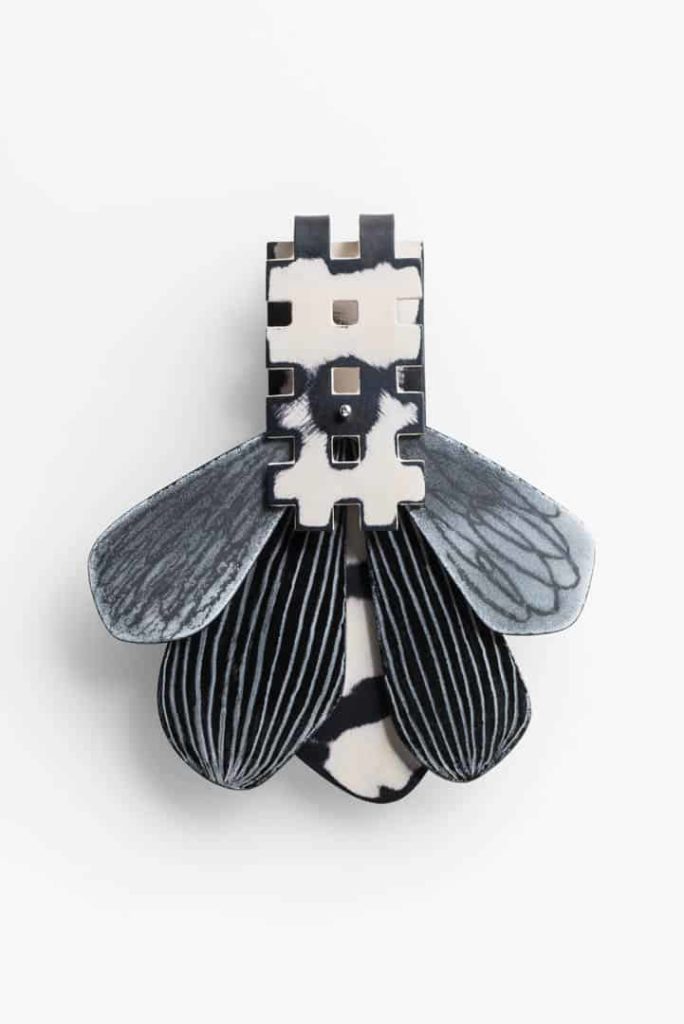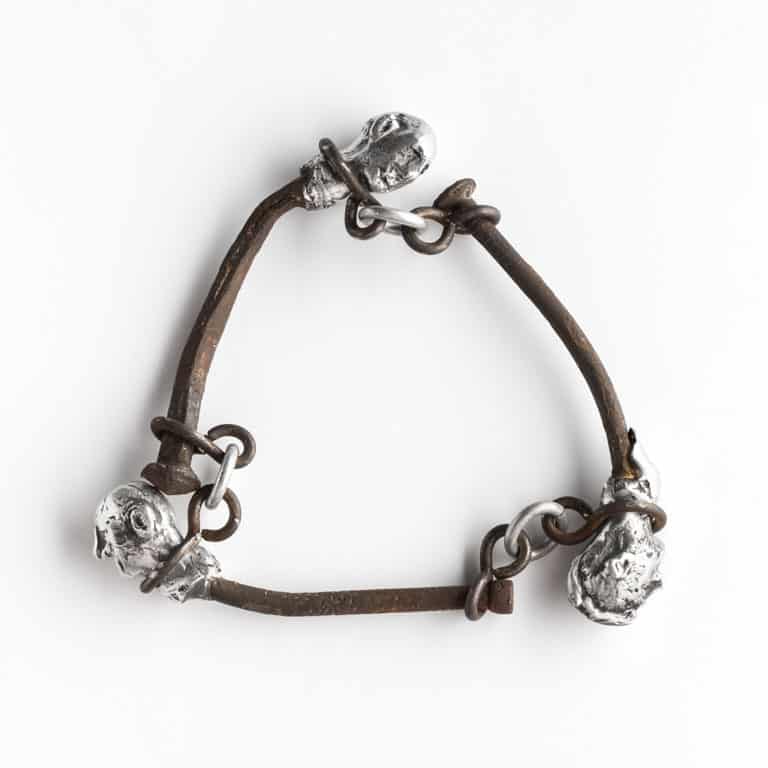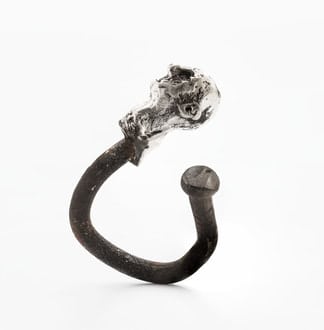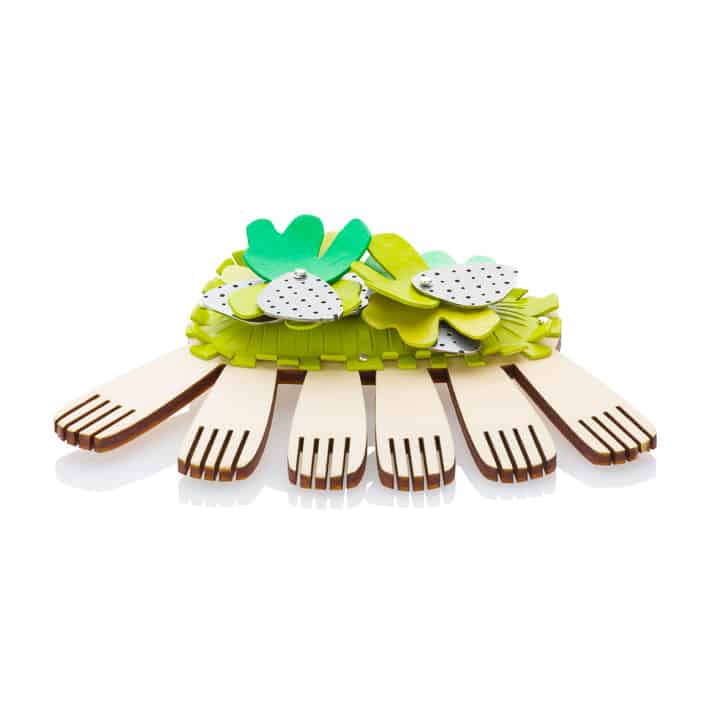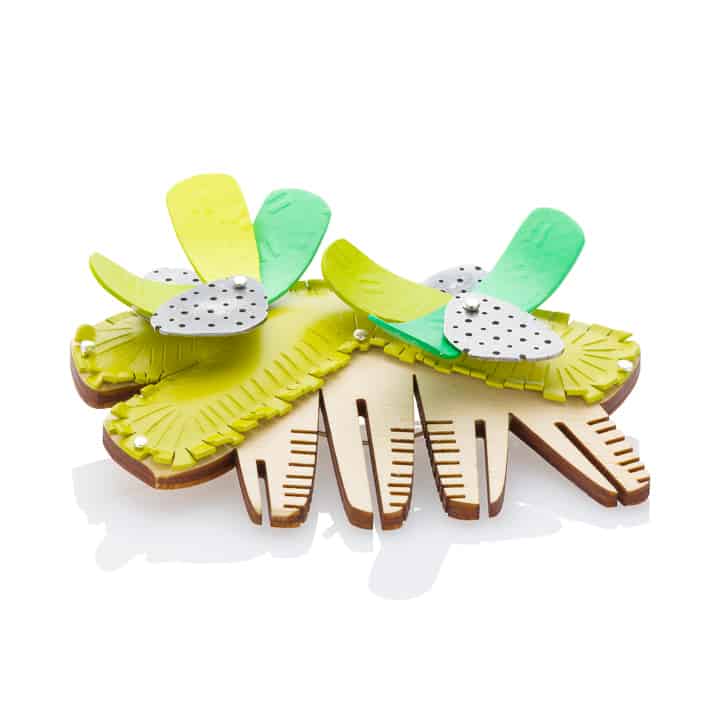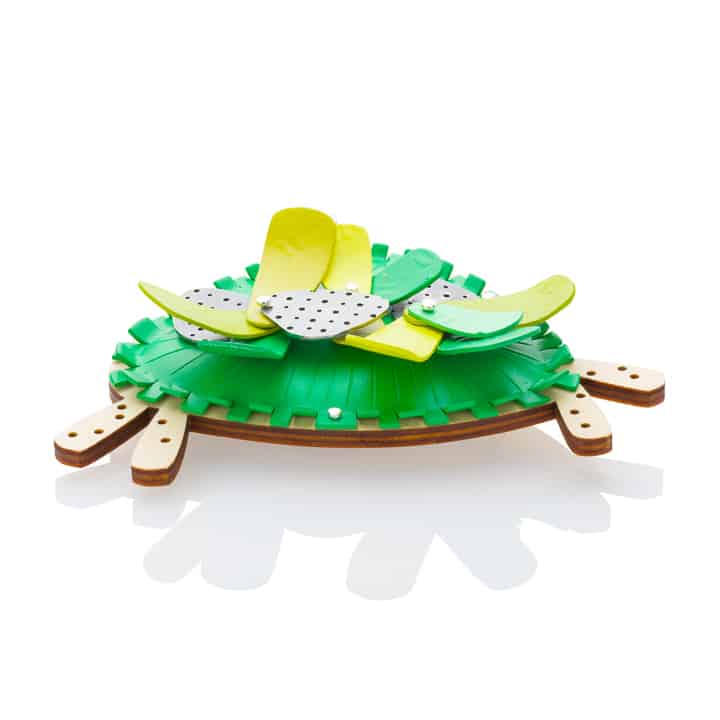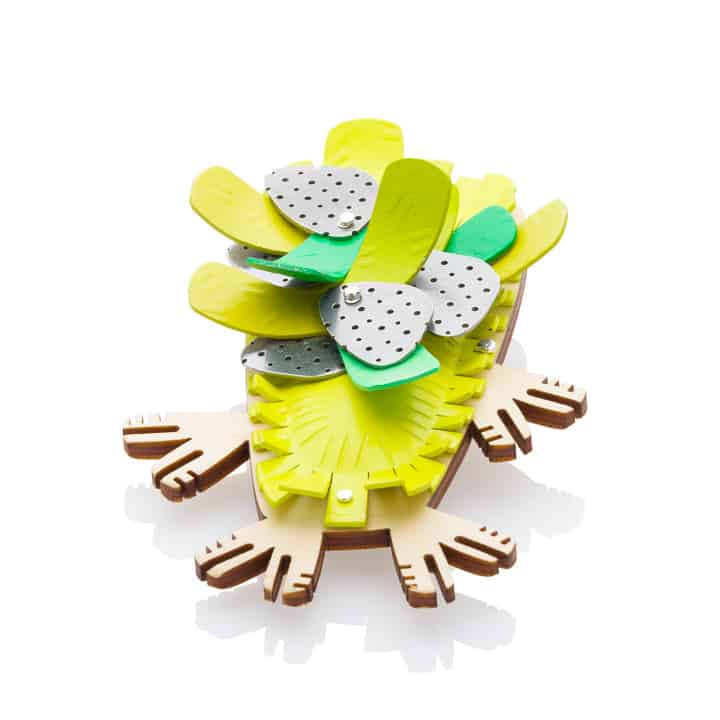- Katie Stormonth Blended Modes & Mediums: Cluster 2018 Sterling silver, aluminium, stainless steel, timber, acrylic paint. Photography: Faun Photography.
- Catherine Large Tea Scoops and Sugar Shovels: Monochrome 2018 Sterling silver, fine silver, carved mother-of-pearl, glass. Photography: Michelle Bowden, Visuall.
- Nellie Peoples Signs and Signals – Exit 2018 Reclaimed steel sign “EXIT”, sterling silver, stainless steel.
- Andy Lowrie Heavy Heart 2017 Vitreous enamel on steel, copper, paint, sterling silver, stainless steel pin. Photography: Michelle Bowden, Visuall.
- Andy Lowrie Wandering Eyes 2017 Vitreous enamel on steel, copper, paint, sterling silver, stainless steel pin. Photography: Michelle Bowden, Visuall.
- Andy Lowrie Paw 2017 Vitreous enamel on steel, copper, paint, sterling silver, stainless steel pin. Photography: Michelle Bowden, Visuall.
- Andy Lowrie Lucky Hand 2017 Vitreous enamel on steel, copper, paint, sterling silver, stainless steel pin. Photography: Michelle Bowden, Visuall.
- Elizabeth Shaw Heads: Nail Head Bracelet 2017 Recycled and reused sterling silver, iron wire, found nails. Photography: Michelle Bowden, Visuall.
- Elizabeth Shaw Heads: Nail Head Ring 2017 Recycled and reused sterling silver, iron wire, found nails. Photography: Michelle Bowden, Visuall.
- Katie Stormonth Blended Modes & Mediums: Combs 2018 Sterling silver, aluminium, stainless steel, timber, acrylic paint. Photography: Faun Photography.
- Katie Stormonth Blended Modes & Mediums: Fronds 2018 Sterling silver, aluminium, stainless steel, timber, acrylic paint. Photography: Faun Photography.
- Katie Stormonth Blended Modes & Mediums: Pod 2018 Sterling silver, aluminium, stainless steel, timber, acrylic paint. Photography: Faun Photography.
- Katie Stormonth Blended Modes & Mediums: Tall 2018 Sterling silver, aluminium, stainless steel, timber, acrylic paint. Photography: Faun Photography.
Use addresses thematic connections jewellers have with their tools and the creations that follow through the extension of the body, further referencing the vital role fingers and hands play in each and every work in this exhibition.
The exhibition is a feast for the eyes and the size of this article makes it difficult to convey the richness of talent and the importance of the topics that are projected through the jewellery and small objects. The careful placement of the collective of concepts by curator Lisa Bryan-Brown ensured the viewer could take the time to soak in the pulse of the exhibition. My mind revelled at the way all the different ideas came together so well in one space. Fortunately, if you miss the exhibition in Brisbane it will be touring Inter and intrastate with the support of Museum and Gallery Services Queensland from 2019-2020.
What caught my eye was the repetition and patterns that occurred in many of the works. As many tools and processes need to be repeated throughout creating, this is an important factor to showcase. I found the work with the most repetition referenced hands and fingers contemplating finger pain and withering hands. Works from Jac Dyson and Andie Lowrie execute beautiful collections of repetition inviting the viewer to imagine the discomfort of the process.
The interaction and exploration of space surrounding the human body was a thought-provoking concept in this exhibition. Not only from the perspective of the maker but also the viewer. Xiaohui Yang explored the body’s intimate spatial relationships with uniquely measured rings and projected beautiful shadows with the form that invoked the process of forming with your hands. Helen Bird’s video projection of human hands interacting with a drawing machine displayed an innovative way to contemplate extension and interaction.
The use of tools as material was discrete and very special in this show. Sam Lintern and Paola Raggo include parts of tools such as loupe lenses and broken saw blades used in an everyday studio workshop to create pieces giving a lease of new life to the tools, leaving the viewer unsuspecting until up close to the work.
It became evident that the environment was a great inspiration to the work and processes to a majority members of this exhibition. Catherine Hunter’s focus on the impact of consumerism on the environment showcased a juxtaposition of traditional crochet techniques with cables and throw-away plastics. Lois Hayes also addresses environmental impact by using marine and fishing implements to reflect on the decrease of local fish populations, a work that is intriguing and quietly menacing. Through magnificent repousse and chasing work on raised silver cups, Alicia Lane’s references the deforestation of trees for purposes of colonialism in Australian history. Clare Poppi explores the idea of a necklace that functions as a tool, through making a mould to produce seed-bomb beads, which can be used for gardening or kept as beads to be threaded onto a necklace.
There were artists who worked with the found or personal materials and allowed these materials to lead them through the creation process. Elizabeth Shaw’s Nail Heads series uses found nails with each nail fitted with a cast silver head, adding a charming pun to the grotesque. Rebecca Ward worked with forged wood and found objects to create abstract works where the absurdity makes perfect sense. Nellie Peoples work with exit signs painted by her grandfather, deconstructed and reworked with precision and Catherine Large’s work takes buttons from a personal collection and gives them a different use and repurposed meaning. The use of the found and the personal has the element of history that is intriguing as it is human nature to look to the past to create the new for the future.
Precision when working with small objects can be a vital part of the jewellery process. Katie Stormonth’s combined use of machine and hand processes to assemble colourfully layered alluring brooches is an example.
The architectural surroundings of artists affect the way work is made, viewed and experienced. Helen Wyatt’s series inspired by shards of glass found at a disused power station reflect an approach to waste and renewal. Kierra-Jay Power’s work explores architecture through the idea of museology display of 3D and hand finished anatomical specimens.
As someone who appreciates the energy, the beauty and workmanship that is involved to make jewellery and small objects it is not common to see a whole exhibition dedicated to the tools and processes that the artist encounters through the journey. This exhibition displays amazing, well-thought concepts and addresses the trials, tribulations and triumphs involved with technique, tools and processes.
Use was a juried exhibition involving seventeen members from the Jewellers and Metalsmiths Group of Queensland, exhibited at Griffith University’s POP Gallery 8-18 February 2018.


